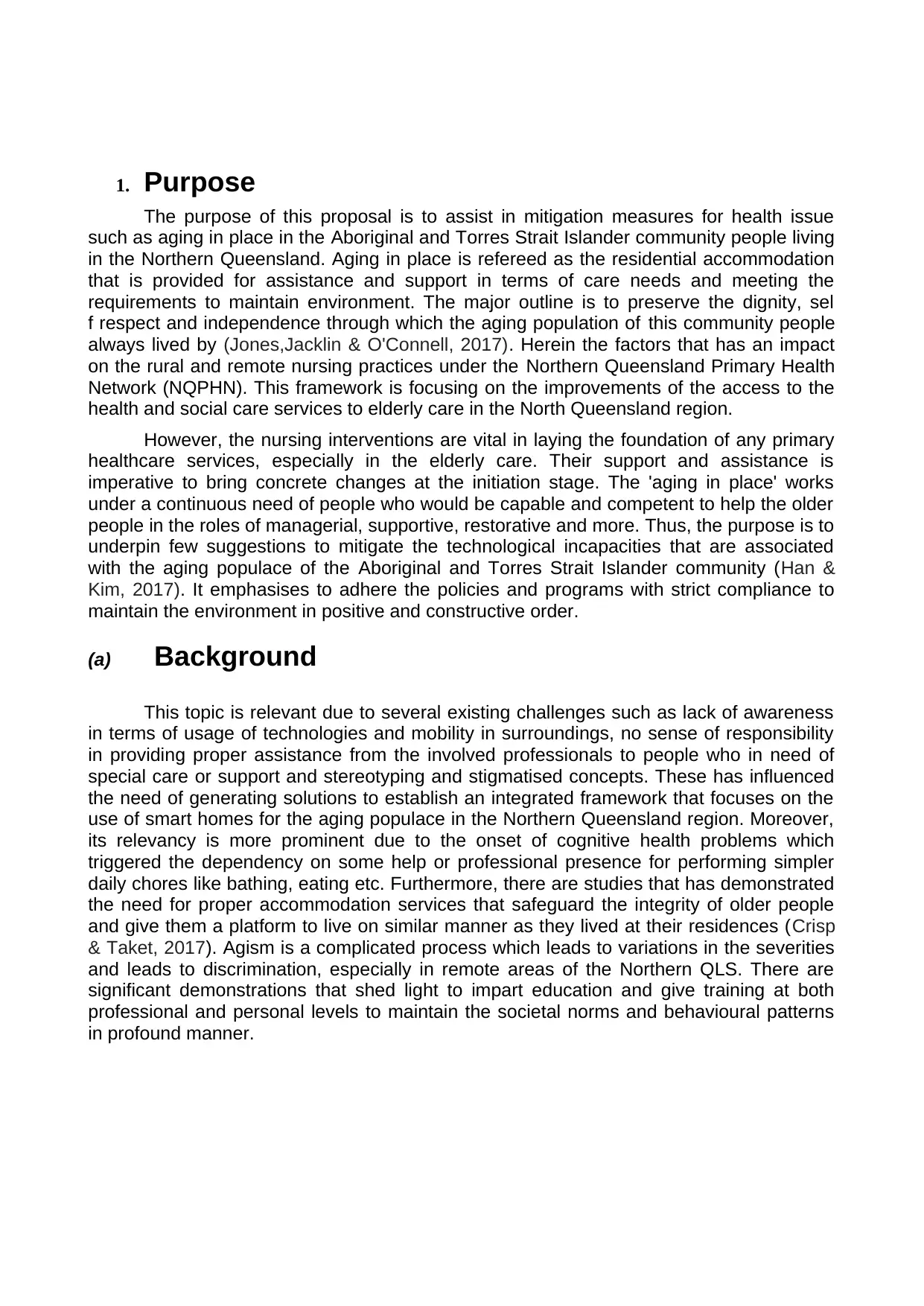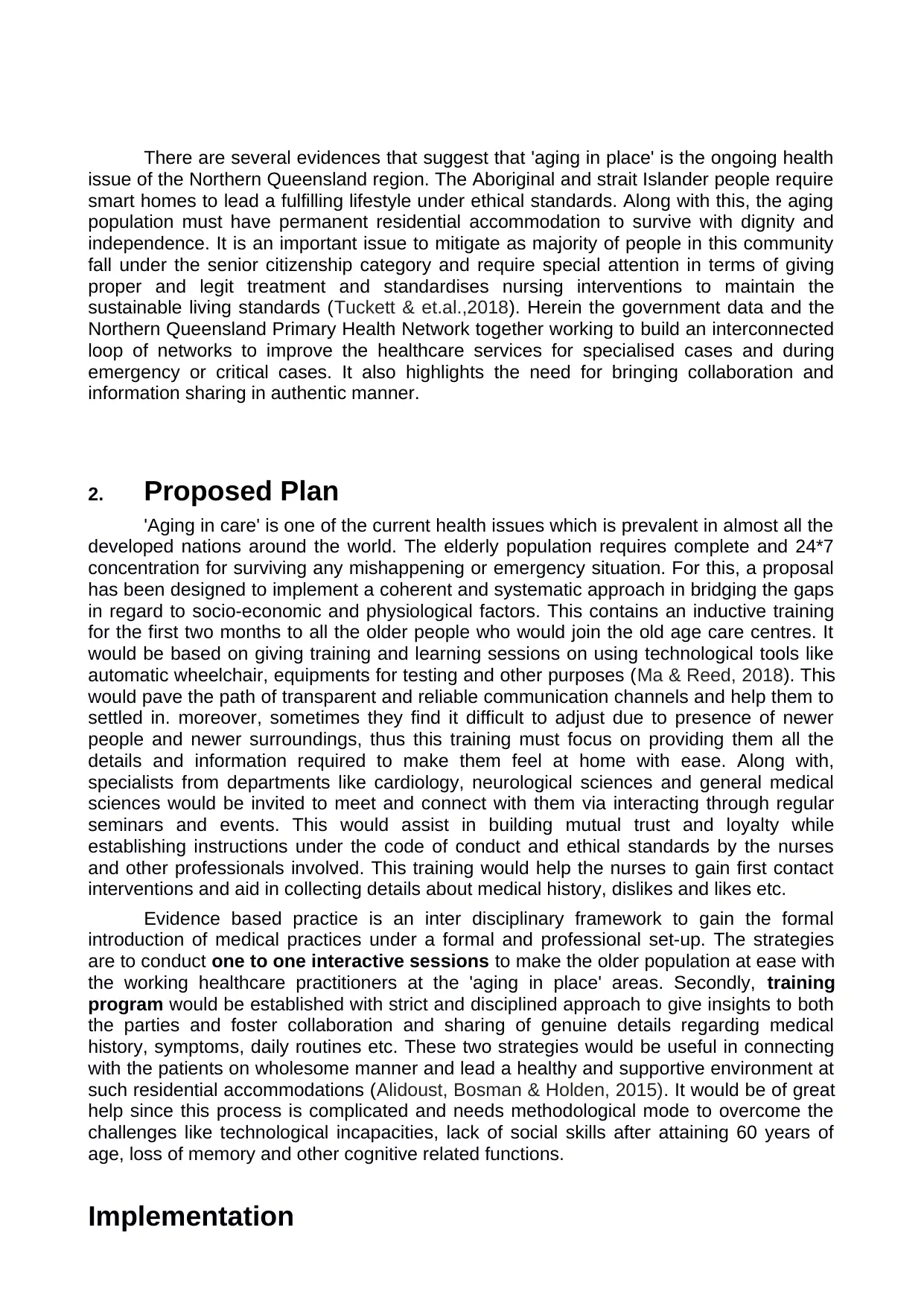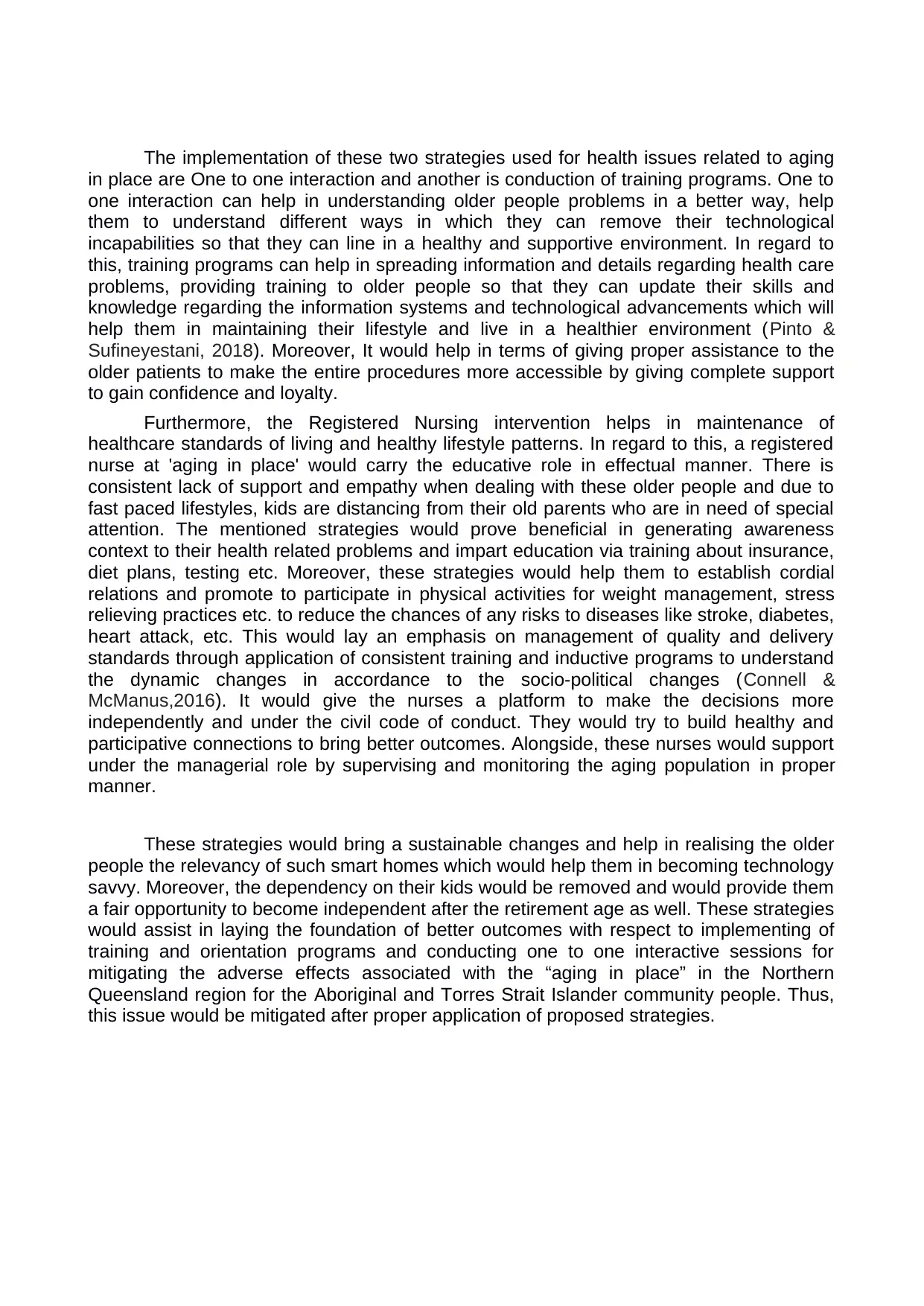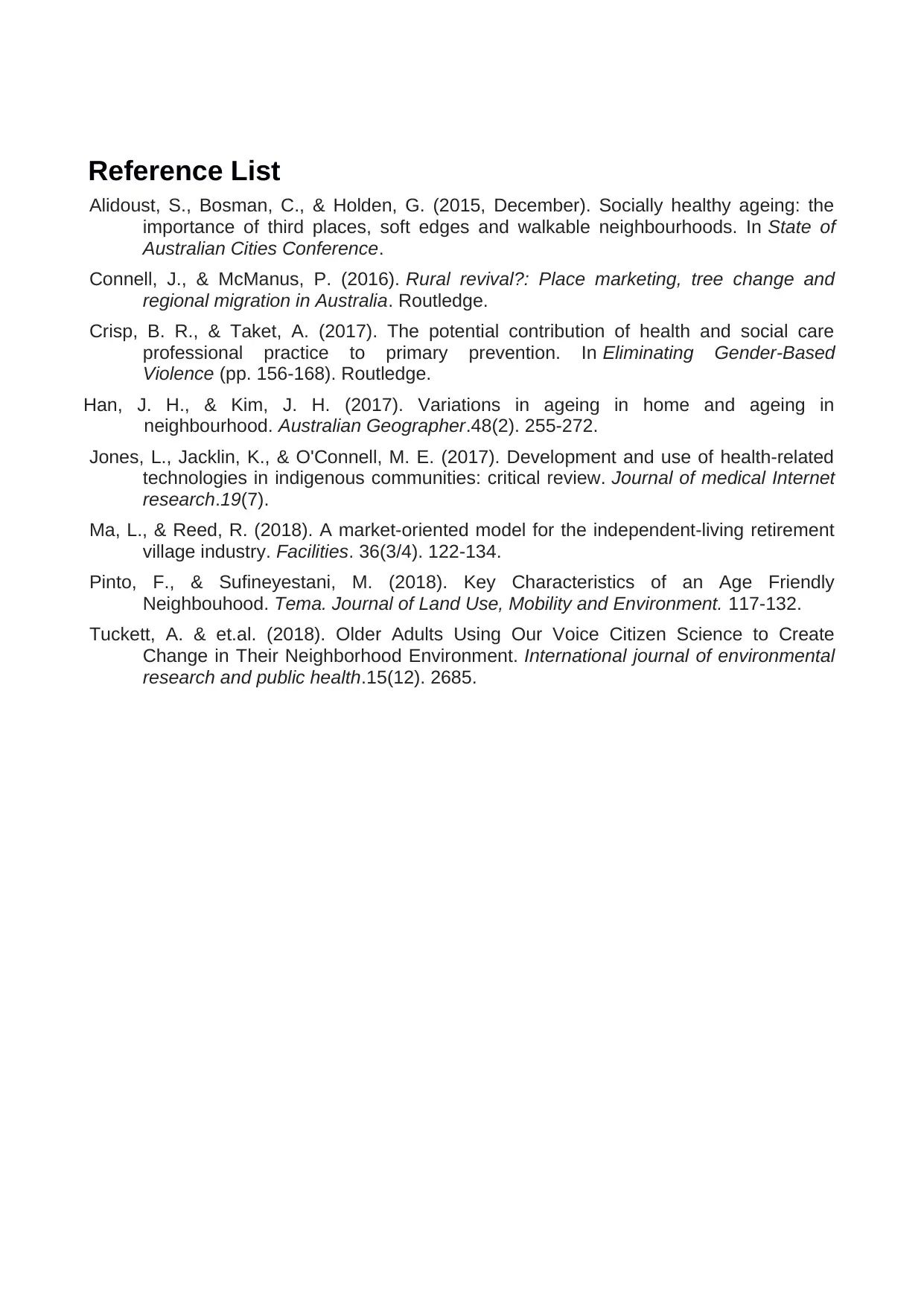Proposal: Addressing Aging in Place for Aboriginal Communities in QLD
VerifiedAdded on 2021/01/02
|5
|1933
|343
Project
AI Summary
This proposal addresses the critical health issue of 'aging in place' within the Aboriginal and Torres Strait Islander communities of Northern Queensland. It highlights challenges such as technological incapacities, lack of awareness, and the need for improved healthcare access, particularly in rural and remote areas. The proposal suggests an integrated framework focused on smart homes, training programs, and one-to-one interactions to address these issues. The plan includes training for older adults on technology, seminars with specialists, and evidence-based practices to foster a supportive environment. Implementation strategies involve one-to-one interactions and training programs to improve technological skills and promote healthy lifestyles. The goal is to enhance the quality of life for the aging population by increasing independence, promoting social connections, and providing comprehensive nursing interventions. The project emphasizes the need for sustainable changes and the importance of community involvement to mitigate the adverse effects of aging in place.

Proposal Template
Project Title: AGING IN PLACE
Project Title: AGING IN PLACE
Paraphrase This Document
Need a fresh take? Get an instant paraphrase of this document with our AI Paraphraser

1. Purpose
The purpose of this proposal is to assist in mitigation measures for health issue
such as aging in place in the Aboriginal and Torres Strait Islander community people living
in the Northern Queensland. Aging in place is refereed as the residential accommodation
that is provided for assistance and support in terms of care needs and meeting the
requirements to maintain environment. The major outline is to preserve the dignity, sel
f respect and independence through which the aging population of this community people
always lived by (Jones,Jacklin & O'Connell, 2017). Herein the factors that has an impact
on the rural and remote nursing practices under the Northern Queensland Primary Health
Network (NQPHN). This framework is focusing on the improvements of the access to the
health and social care services to elderly care in the North Queensland region.
However, the nursing interventions are vital in laying the foundation of any primary
healthcare services, especially in the elderly care. Their support and assistance is
imperative to bring concrete changes at the initiation stage. The 'aging in place' works
under a continuous need of people who would be capable and competent to help the older
people in the roles of managerial, supportive, restorative and more. Thus, the purpose is to
underpin few suggestions to mitigate the technological incapacities that are associated
with the aging populace of the Aboriginal and Torres Strait Islander community (Han &
Kim, 2017). It emphasises to adhere the policies and programs with strict compliance to
maintain the environment in positive and constructive order.
(a) Background
This topic is relevant due to several existing challenges such as lack of awareness
in terms of usage of technologies and mobility in surroundings, no sense of responsibility
in providing proper assistance from the involved professionals to people who in need of
special care or support and stereotyping and stigmatised concepts. These has influenced
the need of generating solutions to establish an integrated framework that focuses on the
use of smart homes for the aging populace in the Northern Queensland region. Moreover,
its relevancy is more prominent due to the onset of cognitive health problems which
triggered the dependency on some help or professional presence for performing simpler
daily chores like bathing, eating etc. Furthermore, there are studies that has demonstrated
the need for proper accommodation services that safeguard the integrity of older people
and give them a platform to live on similar manner as they lived at their residences (Crisp
& Taket, 2017). Agism is a complicated process which leads to variations in the severities
and leads to discrimination, especially in remote areas of the Northern QLS. There are
significant demonstrations that shed light to impart education and give training at both
professional and personal levels to maintain the societal norms and behavioural patterns
in profound manner.
The purpose of this proposal is to assist in mitigation measures for health issue
such as aging in place in the Aboriginal and Torres Strait Islander community people living
in the Northern Queensland. Aging in place is refereed as the residential accommodation
that is provided for assistance and support in terms of care needs and meeting the
requirements to maintain environment. The major outline is to preserve the dignity, sel
f respect and independence through which the aging population of this community people
always lived by (Jones,Jacklin & O'Connell, 2017). Herein the factors that has an impact
on the rural and remote nursing practices under the Northern Queensland Primary Health
Network (NQPHN). This framework is focusing on the improvements of the access to the
health and social care services to elderly care in the North Queensland region.
However, the nursing interventions are vital in laying the foundation of any primary
healthcare services, especially in the elderly care. Their support and assistance is
imperative to bring concrete changes at the initiation stage. The 'aging in place' works
under a continuous need of people who would be capable and competent to help the older
people in the roles of managerial, supportive, restorative and more. Thus, the purpose is to
underpin few suggestions to mitigate the technological incapacities that are associated
with the aging populace of the Aboriginal and Torres Strait Islander community (Han &
Kim, 2017). It emphasises to adhere the policies and programs with strict compliance to
maintain the environment in positive and constructive order.
(a) Background
This topic is relevant due to several existing challenges such as lack of awareness
in terms of usage of technologies and mobility in surroundings, no sense of responsibility
in providing proper assistance from the involved professionals to people who in need of
special care or support and stereotyping and stigmatised concepts. These has influenced
the need of generating solutions to establish an integrated framework that focuses on the
use of smart homes for the aging populace in the Northern Queensland region. Moreover,
its relevancy is more prominent due to the onset of cognitive health problems which
triggered the dependency on some help or professional presence for performing simpler
daily chores like bathing, eating etc. Furthermore, there are studies that has demonstrated
the need for proper accommodation services that safeguard the integrity of older people
and give them a platform to live on similar manner as they lived at their residences (Crisp
& Taket, 2017). Agism is a complicated process which leads to variations in the severities
and leads to discrimination, especially in remote areas of the Northern QLS. There are
significant demonstrations that shed light to impart education and give training at both
professional and personal levels to maintain the societal norms and behavioural patterns
in profound manner.

There are several evidences that suggest that 'aging in place' is the ongoing health
issue of the Northern Queensland region. The Aboriginal and strait Islander people require
smart homes to lead a fulfilling lifestyle under ethical standards. Along with this, the aging
population must have permanent residential accommodation to survive with dignity and
independence. It is an important issue to mitigate as majority of people in this community
fall under the senior citizenship category and require special attention in terms of giving
proper and legit treatment and standardises nursing interventions to maintain the
sustainable living standards (Tuckett & et.al.,2018). Herein the government data and the
Northern Queensland Primary Health Network together working to build an interconnected
loop of networks to improve the healthcare services for specialised cases and during
emergency or critical cases. It also highlights the need for bringing collaboration and
information sharing in authentic manner.
2. Proposed Plan
'Aging in care' is one of the current health issues which is prevalent in almost all the
developed nations around the world. The elderly population requires complete and 24*7
concentration for surviving any mishappening or emergency situation. For this, a proposal
has been designed to implement a coherent and systematic approach in bridging the gaps
in regard to socio-economic and physiological factors. This contains an inductive training
for the first two months to all the older people who would join the old age care centres. It
would be based on giving training and learning sessions on using technological tools like
automatic wheelchair, equipments for testing and other purposes (Ma & Reed, 2018). This
would pave the path of transparent and reliable communication channels and help them to
settled in. moreover, sometimes they find it difficult to adjust due to presence of newer
people and newer surroundings, thus this training must focus on providing them all the
details and information required to make them feel at home with ease. Along with,
specialists from departments like cardiology, neurological sciences and general medical
sciences would be invited to meet and connect with them via interacting through regular
seminars and events. This would assist in building mutual trust and loyalty while
establishing instructions under the code of conduct and ethical standards by the nurses
and other professionals involved. This training would help the nurses to gain first contact
interventions and aid in collecting details about medical history, dislikes and likes etc.
Evidence based practice is an inter disciplinary framework to gain the formal
introduction of medical practices under a formal and professional set-up. The strategies
are to conduct one to one interactive sessions to make the older population at ease with
the working healthcare practitioners at the 'aging in place' areas. Secondly, training
program would be established with strict and disciplined approach to give insights to both
the parties and foster collaboration and sharing of genuine details regarding medical
history, symptoms, daily routines etc. These two strategies would be useful in connecting
with the patients on wholesome manner and lead a healthy and supportive environment at
such residential accommodations (Alidoust, Bosman & Holden, 2015). It would be of great
help since this process is complicated and needs methodological mode to overcome the
challenges like technological incapacities, lack of social skills after attaining 60 years of
age, loss of memory and other cognitive related functions.
Implementation
issue of the Northern Queensland region. The Aboriginal and strait Islander people require
smart homes to lead a fulfilling lifestyle under ethical standards. Along with this, the aging
population must have permanent residential accommodation to survive with dignity and
independence. It is an important issue to mitigate as majority of people in this community
fall under the senior citizenship category and require special attention in terms of giving
proper and legit treatment and standardises nursing interventions to maintain the
sustainable living standards (Tuckett & et.al.,2018). Herein the government data and the
Northern Queensland Primary Health Network together working to build an interconnected
loop of networks to improve the healthcare services for specialised cases and during
emergency or critical cases. It also highlights the need for bringing collaboration and
information sharing in authentic manner.
2. Proposed Plan
'Aging in care' is one of the current health issues which is prevalent in almost all the
developed nations around the world. The elderly population requires complete and 24*7
concentration for surviving any mishappening or emergency situation. For this, a proposal
has been designed to implement a coherent and systematic approach in bridging the gaps
in regard to socio-economic and physiological factors. This contains an inductive training
for the first two months to all the older people who would join the old age care centres. It
would be based on giving training and learning sessions on using technological tools like
automatic wheelchair, equipments for testing and other purposes (Ma & Reed, 2018). This
would pave the path of transparent and reliable communication channels and help them to
settled in. moreover, sometimes they find it difficult to adjust due to presence of newer
people and newer surroundings, thus this training must focus on providing them all the
details and information required to make them feel at home with ease. Along with,
specialists from departments like cardiology, neurological sciences and general medical
sciences would be invited to meet and connect with them via interacting through regular
seminars and events. This would assist in building mutual trust and loyalty while
establishing instructions under the code of conduct and ethical standards by the nurses
and other professionals involved. This training would help the nurses to gain first contact
interventions and aid in collecting details about medical history, dislikes and likes etc.
Evidence based practice is an inter disciplinary framework to gain the formal
introduction of medical practices under a formal and professional set-up. The strategies
are to conduct one to one interactive sessions to make the older population at ease with
the working healthcare practitioners at the 'aging in place' areas. Secondly, training
program would be established with strict and disciplined approach to give insights to both
the parties and foster collaboration and sharing of genuine details regarding medical
history, symptoms, daily routines etc. These two strategies would be useful in connecting
with the patients on wholesome manner and lead a healthy and supportive environment at
such residential accommodations (Alidoust, Bosman & Holden, 2015). It would be of great
help since this process is complicated and needs methodological mode to overcome the
challenges like technological incapacities, lack of social skills after attaining 60 years of
age, loss of memory and other cognitive related functions.
Implementation
⊘ This is a preview!⊘
Do you want full access?
Subscribe today to unlock all pages.

Trusted by 1+ million students worldwide

The implementation of these two strategies used for health issues related to aging
in place are One to one interaction and another is conduction of training programs. One to
one interaction can help in understanding older people problems in a better way, help
them to understand different ways in which they can remove their technological
incapabilities so that they can line in a healthy and supportive environment. In regard to
this, training programs can help in spreading information and details regarding health care
problems, providing training to older people so that they can update their skills and
knowledge regarding the information systems and technological advancements which will
help them in maintaining their lifestyle and live in a healthier environment (Pinto &
Sufineyestani, 2018). Moreover, It would help in terms of giving proper assistance to the
older patients to make the entire procedures more accessible by giving complete support
to gain confidence and loyalty.
Furthermore, the Registered Nursing intervention helps in maintenance of
healthcare standards of living and healthy lifestyle patterns. In regard to this, a registered
nurse at 'aging in place' would carry the educative role in effectual manner. There is
consistent lack of support and empathy when dealing with these older people and due to
fast paced lifestyles, kids are distancing from their old parents who are in need of special
attention. The mentioned strategies would prove beneficial in generating awareness
context to their health related problems and impart education via training about insurance,
diet plans, testing etc. Moreover, these strategies would help them to establish cordial
relations and promote to participate in physical activities for weight management, stress
relieving practices etc. to reduce the chances of any risks to diseases like stroke, diabetes,
heart attack, etc. This would lay an emphasis on management of quality and delivery
standards through application of consistent training and inductive programs to understand
the dynamic changes in accordance to the socio-political changes (Connell &
McManus,2016). It would give the nurses a platform to make the decisions more
independently and under the civil code of conduct. They would try to build healthy and
participative connections to bring better outcomes. Alongside, these nurses would support
under the managerial role by supervising and monitoring the aging population in proper
manner.
These strategies would bring a sustainable changes and help in realising the older
people the relevancy of such smart homes which would help them in becoming technology
savvy. Moreover, the dependency on their kids would be removed and would provide them
a fair opportunity to become independent after the retirement age as well. These strategies
would assist in laying the foundation of better outcomes with respect to implementing of
training and orientation programs and conducting one to one interactive sessions for
mitigating the adverse effects associated with the “aging in place” in the Northern
Queensland region for the Aboriginal and Torres Strait Islander community people. Thus,
this issue would be mitigated after proper application of proposed strategies.
in place are One to one interaction and another is conduction of training programs. One to
one interaction can help in understanding older people problems in a better way, help
them to understand different ways in which they can remove their technological
incapabilities so that they can line in a healthy and supportive environment. In regard to
this, training programs can help in spreading information and details regarding health care
problems, providing training to older people so that they can update their skills and
knowledge regarding the information systems and technological advancements which will
help them in maintaining their lifestyle and live in a healthier environment (Pinto &
Sufineyestani, 2018). Moreover, It would help in terms of giving proper assistance to the
older patients to make the entire procedures more accessible by giving complete support
to gain confidence and loyalty.
Furthermore, the Registered Nursing intervention helps in maintenance of
healthcare standards of living and healthy lifestyle patterns. In regard to this, a registered
nurse at 'aging in place' would carry the educative role in effectual manner. There is
consistent lack of support and empathy when dealing with these older people and due to
fast paced lifestyles, kids are distancing from their old parents who are in need of special
attention. The mentioned strategies would prove beneficial in generating awareness
context to their health related problems and impart education via training about insurance,
diet plans, testing etc. Moreover, these strategies would help them to establish cordial
relations and promote to participate in physical activities for weight management, stress
relieving practices etc. to reduce the chances of any risks to diseases like stroke, diabetes,
heart attack, etc. This would lay an emphasis on management of quality and delivery
standards through application of consistent training and inductive programs to understand
the dynamic changes in accordance to the socio-political changes (Connell &
McManus,2016). It would give the nurses a platform to make the decisions more
independently and under the civil code of conduct. They would try to build healthy and
participative connections to bring better outcomes. Alongside, these nurses would support
under the managerial role by supervising and monitoring the aging population in proper
manner.
These strategies would bring a sustainable changes and help in realising the older
people the relevancy of such smart homes which would help them in becoming technology
savvy. Moreover, the dependency on their kids would be removed and would provide them
a fair opportunity to become independent after the retirement age as well. These strategies
would assist in laying the foundation of better outcomes with respect to implementing of
training and orientation programs and conducting one to one interactive sessions for
mitigating the adverse effects associated with the “aging in place” in the Northern
Queensland region for the Aboriginal and Torres Strait Islander community people. Thus,
this issue would be mitigated after proper application of proposed strategies.
Paraphrase This Document
Need a fresh take? Get an instant paraphrase of this document with our AI Paraphraser

Reference List
Alidoust, S., Bosman, C., & Holden, G. (2015, December). Socially healthy ageing: the
importance of third places, soft edges and walkable neighbourhoods. In State of
Australian Cities Conference.
Connell, J., & McManus, P. (2016). Rural revival?: Place marketing, tree change and
regional migration in Australia. Routledge.
Crisp, B. R., & Taket, A. (2017). The potential contribution of health and social care
professional practice to primary prevention. In Eliminating Gender-Based
Violence (pp. 156-168). Routledge.
Han, J. H., & Kim, J. H. (2017). Variations in ageing in home and ageing in
neighbourhood. Australian Geographer.48(2). 255-272.
Jones, L., Jacklin, K., & O'Connell, M. E. (2017). Development and use of health-related
technologies in indigenous communities: critical review. Journal of medical Internet
research.19(7).
Ma, L., & Reed, R. (2018). A market-oriented model for the independent-living retirement
village industry. Facilities. 36(3/4). 122-134.
Pinto, F., & Sufineyestani, M. (2018). Key Characteristics of an Age Friendly
Neighbouhood. Tema. Journal of Land Use, Mobility and Environment. 117-132.
Tuckett, A. & et.al. (2018). Older Adults Using Our Voice Citizen Science to Create
Change in Their Neighborhood Environment. International journal of environmental
research and public health.15(12). 2685.
Alidoust, S., Bosman, C., & Holden, G. (2015, December). Socially healthy ageing: the
importance of third places, soft edges and walkable neighbourhoods. In State of
Australian Cities Conference.
Connell, J., & McManus, P. (2016). Rural revival?: Place marketing, tree change and
regional migration in Australia. Routledge.
Crisp, B. R., & Taket, A. (2017). The potential contribution of health and social care
professional practice to primary prevention. In Eliminating Gender-Based
Violence (pp. 156-168). Routledge.
Han, J. H., & Kim, J. H. (2017). Variations in ageing in home and ageing in
neighbourhood. Australian Geographer.48(2). 255-272.
Jones, L., Jacklin, K., & O'Connell, M. E. (2017). Development and use of health-related
technologies in indigenous communities: critical review. Journal of medical Internet
research.19(7).
Ma, L., & Reed, R. (2018). A market-oriented model for the independent-living retirement
village industry. Facilities. 36(3/4). 122-134.
Pinto, F., & Sufineyestani, M. (2018). Key Characteristics of an Age Friendly
Neighbouhood. Tema. Journal of Land Use, Mobility and Environment. 117-132.
Tuckett, A. & et.al. (2018). Older Adults Using Our Voice Citizen Science to Create
Change in Their Neighborhood Environment. International journal of environmental
research and public health.15(12). 2685.
1 out of 5
Related Documents
Your All-in-One AI-Powered Toolkit for Academic Success.
+13062052269
info@desklib.com
Available 24*7 on WhatsApp / Email
![[object Object]](/_next/static/media/star-bottom.7253800d.svg)
Unlock your academic potential
Copyright © 2020–2025 A2Z Services. All Rights Reserved. Developed and managed by ZUCOL.





